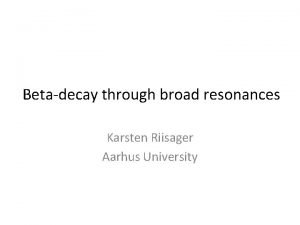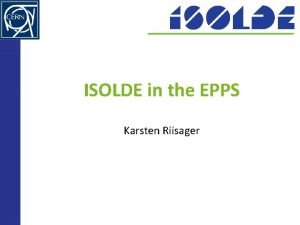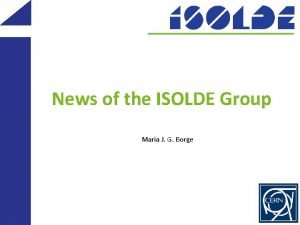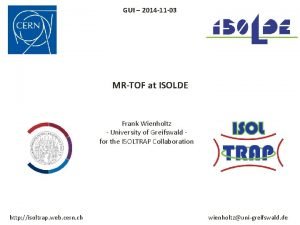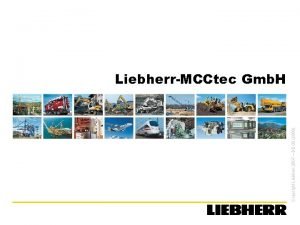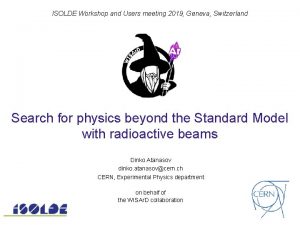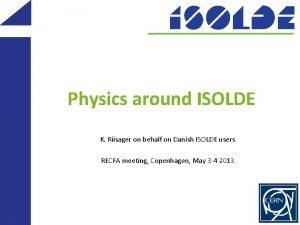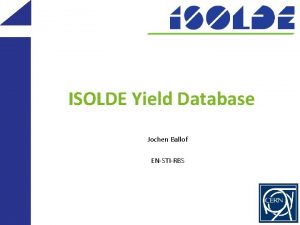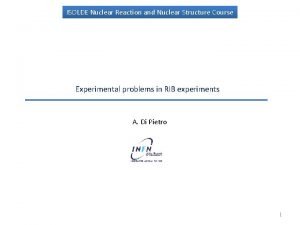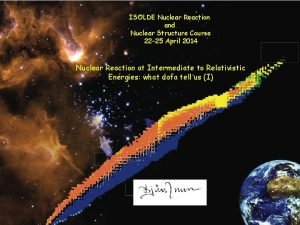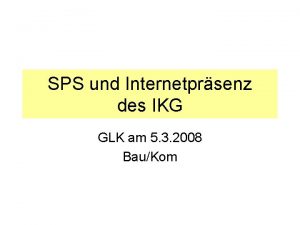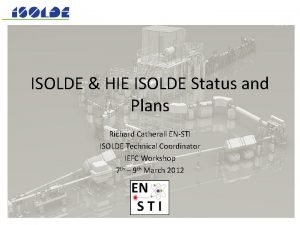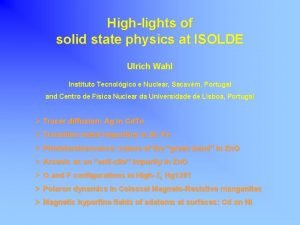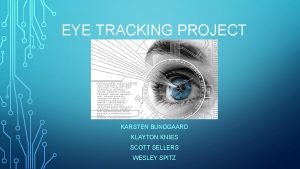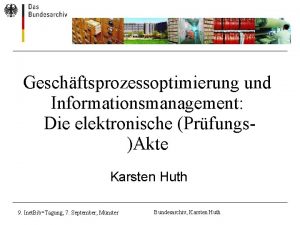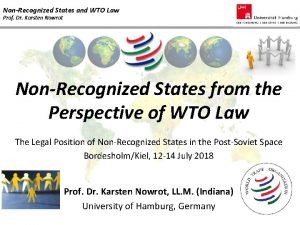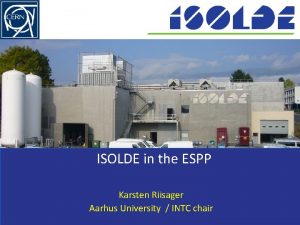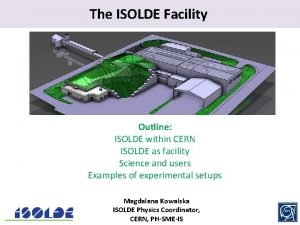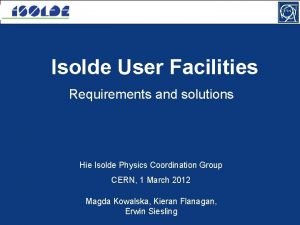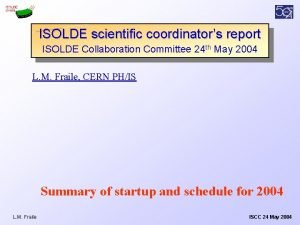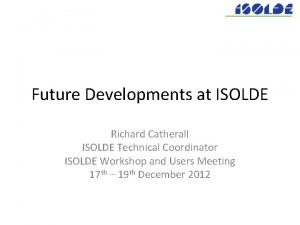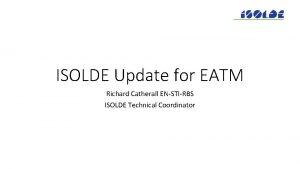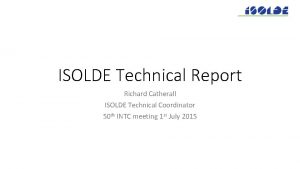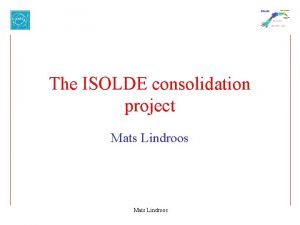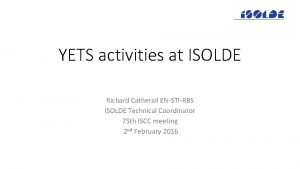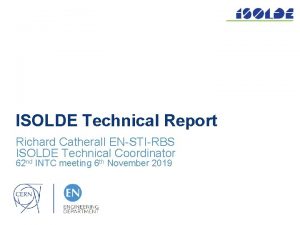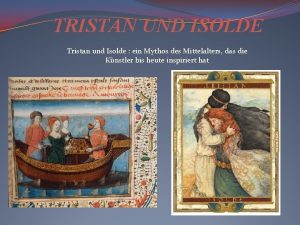ISOLDE in the EPPS Karsten Riisager 2 European


















- Slides: 18

ISOLDE in the EPPS Karsten Riisager

2

European Strategy Group (ESG) The European Strategy Group (ESG) is a special body set up by the CERN Council approximately every five years, with the remit to establish a proposal for the periodic update of the medium-and long-term European Strategy for Particle Physics which it submits to the CERN Council for approval. ü ü ü ü Members: the Strategy Secretary (acting as Chair), one representative appointed by each CERN Member State, one representative appointed by each of the Laboratories participating in the major European Laboratory Directors’ meetings, including its Chair (CERN, CIEMAT (Madrid-Spain), DESY (Hamburg-Germany), Irfu (Saclay-France), LAL (Orsay. France), Nikhef (Amsterdam-Netherlands), LNF (Frascati-Italy), LNGS (Gran Sasso-Italy), PSI (Villigen-Switzerland), STFC-RAL (Didcot-UK)), the CERN Director-General, Fabiola Giannoti the SPC Chair, Marie-Hélène Schune (LAL, Orsay) the ECFA Chair, Jorgen D’Hondt Invited: the President of the CERN Council, Sijbrand de Jong / Ursula Bassler one representative from each of the Associate Member States, one representative from each Observer State, one representative from the European Commission, the Chairs of Ap. PEC and Nu. PECC (Marek Lewitowicz), the Chairs of FALC and ESFRI, the members of the Physics Preparatory Group. Invitees are entitled to attend all open meetings of the ESG and to take the floor. 3

Physics Preparatory Group (PPG) The remit of the Physics Preparatory Group (PPG) is to prepare the scientific contribution to the work of the ESG (the “Briefing Book”), based on the input it gathers from the community. The PPG has the following composition: Members: the Strategy Secretary (acting as Chair), four members appointed by the Council on the recommendation of the SPC, four members appointed by the Council on the recommendation of ECFA, the SPC Chair, Marie-Hélène Schune (LAL, Orsay) the ECFA Chair, Jorgen D’Hondt the Chair of the European Laboratory Directors’ meeting, one representative appointed by CERN, two representatives from Asia appointed by the respective regional representatives in ICFA, ü two representatives from the Americas appointed by the respective regional representatives in ICFA. ü ü ü ü 4

ESPP Guidelines Main document: Ø a pdf file containing a cover page (title, abstract, name of the contact person and his/her e-mail address) Ø a comprehensive and self-contained description of the proposed input (maximum 10 pages). This document should address the scientific context, objectives, methodology, readiness and expected challenges. Addendum: Ø a pdf file containing information on the following ü interested community, ü timeline, ü construction and operating costs, ü computing requirements. Ø The name of this pdf file should be as follows: "Addendum-NN. pdf", where NN is the file-name of your main document. For confidential addenda: If you wish the addendum to be treated as confidential (i. e. limited to the PPG and ESG), you should send it to the following email address eppsu. addenda@espace. cern. ch by 18 December 2018 5

Submission and after Submitted documents: Ø Once submitted, both documents will be passed on to the ü Physics Preparatory Group (PPG) ü European Strategy Group (ESG), Ø All will be made public in January 2019 for the community. Open Symposium, 13 -16 May 2019, Granada, Spain Drafting session, 20 -24 January 2020, Bad Honef, Germany (PPG and ESG? ) May 2020 – approval of the document by the CERN Council (recommendations for future of CERN experiments and developments) 6

The Future of (HIE-)ISOLDE The EPIC project: Exploiting the Potential of ISOLDE at CERN (the ISOLDE Collaboration input to the European Particle Physics Strategy update) http: //europeanstrategyupdate. web. cern. ch/process-0 Richard Catherall, Gerda Neyens, Karsten Riisager, Bertram Blank With thanks to Klaus Blaum, Yuri Litvinov, Ronald Garcia Ruiz, Kieran Flanagan, Manfred Grieser, Erwin Siesling, Tim Giles 7

Present ISOLDE beams Nearly 1300 isotopes available from over 72 chemical elements largest choice for any ISOL facility in the world More than 80 isotopes have been efficiently re-accelerated with REX/HIE-ISOLDE 8

The ISOLDE users community Since post-accelerated beams became available: ever expanding users community ! ISOLDE USERS: Ø In pre-HIE-ISOLDE era: 500 -600 Ø Today: 1314 ! ü From 43 countries ü From > 200 institutions ü From all around the world 9

5 objectives Improve the exploitation of the existing infrastructure Profit from increased driver beam energy and intensity (2 Ge. V, 4 m. A) A new storage ring for short-lived light and heavy ions Have multiple simultaneous beams for users Meet modern radioprotection standards. 10

Objective 1 1. Improve the exploitation of the existing infrastructure Ø HIE-ISOLDE post-accelerator design goal: beams up to 10 Me. V/u ü Have all cavities working after LS 2 ! Ø FINALIZE the HIE-ISOLDE energy upgrade: post-accelerated beams in the full (low) energy range from 0. 3 and 2. 8 Me. V/u (most important for astrophysics experiments) METHOD: upgrade of the REX-part (normal conducting section) ü Using SC cavities allow for more continuous energy ü But: IH structure will be limiting factor – also needs to be addressed ! ü Alternative: new IH and normal conducting cavities higher A/Q higher intensity for the heavy elements ! 11

Objective 2 2. Profit from increased driver beam energy (2 Ge. V) and intensity (4 m. A) Ø Take advantage of CERN’s LHC Injector Upgrade (LIU): higher proton intensities from LINAC 4 and Booster energy increase from 1. 4 Ge. V to 2 Ge. V Ø GAIN FOR ISOLDE: Higher radioactive beam intensities for fragmentation and spallation products (between factor of 2 and more than 10 increase in intensity) Ø NEEDS FOR ISOLDE TO RECEIVE THESE BEAMS: ü New beam dumps to cope with higher power ü New transfer line from booster to ISOLDE 12

Objective 3 3. A new compact storage ring for light and heavy ions Ø Stored radioactive beams have many advantageous: Eur. Phys. J. Special Topics 207, 1 -117 (2012) - Can be used multiple times in an in-ring detector (luminosity increase) - Can be cooled to deliver excellent quality beams to external experiments for high-precision studies Ø Research areas: nuclear ground-state properties, reaction studies of astrophysical relevance, investigations with highly-charged ions studies with pure isomeric beams (e. g. fundamental constants) 13

History of a storage ring @ISOLDE TSR@ISOLDE workshop at MPI-K Heidelberg evaluated the future for TSR Oct 2010 ISOLDE and Neutron Time-of-Flight Committee endorsed Jan 2012 TSR technical design report, 129 co-authors (47 institutions) EPJ Special Topics 207 1 -117 May 2012 Approved by CERN Research board, May 2012 “The installation of TSR, as an experiment to be included in the HIE-ISOLDE programme, was approved by the Research Board. The timescale will be defined once the study of its Integration has been completed. ” Presentation of the integration study to the CERN Research Board Nov 2013 Several TSR@ISOLDE workshops at CERN: 2012, 2014, 2015 Updated CERN integration study with report to the CERN directorate 2016 CERN director general: decision about the TSR@ISOLDE project is postponed until 2020/2021 (after second LHC upgrade ) August/September 2016 MPIK cannot hold TSR at MPIK until 2020/2021 without getting green light from CERN

Objective 3 3. A new compact storage ring for light and heavy ions 10 m Preliminary design: Manfred Grieser, MPI-K Heidelberg Preliminary integration in ISOLDE: Erwin Siesling 15

Objective 4 4. Have multiple simultaneous and better quality beams Ø GOAL: serve the ever growing ISOLDE users community, who persues very diverse research program in nuclear physics, fundamental interaction studies, atomic physics nuclear astrophysics material sciences biochemical/ medical research Target 1 Target 2 Ø METHOD: 1. Two new additional target stations Preliminary design: Tim Giles, presented at the EMIS 2018 Conference, CERN 16

Objective 4 4. Have multiple simultaneous better quality beams Ø METHOD: 1. Two new additional target stations 2. A new high-resolution mass separator (state-of-the-art) to deliver purer beams (very important for HIE-ISOLDE operations) currently, some RIB’s beams cannot be efficiently accelerated due to contamination that is too high Target 1 Target 2 Preliminary design: Tim Giles, presented at the EMIS 2018 Conference, CERN 17

Impact on Physics Most of HIE-ISOLDE and many ISOLDE proposals suffer from low intensity unnecessary prolongation of beam times. New and more exotic species will be available with the increase of intensities: from x 2 -x 5 for fragmentation, x 1 – x 2 for fission, x 6 -x 10 for spallation. Several HIE-ISOLDE experiments cannot reach full intensity due to contamination in the ISOLDE beam need better beam purification (new HRS mass separator, …) New target stations will allow operation of low-energy and high-energy experiments, thus doubling the available beam time. 18
